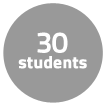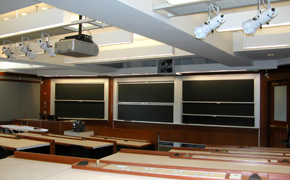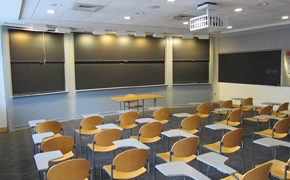This Course at MIT pages are part of the OCW Educator initiative, which seeks to enhance the value of OCW for educators.
Course Overview
This page focuses on the course 6.849 Geometric Folding Algorithms: Linkages, Origami, Polyhedra as it was taught by Prof. Erik Demaine in Fall 2012.
This course is about folding forms, which encompasses any kind of reconfigurable structure that can change shape dynamically. There is a lot of excitement about applying folding to various disciplines such as science and engineering. The applications motivate the underlying mathematics of how to understand reconfigurable structures, the algorithms of how to fold your robotic arm into a desired shape, and even how to design new origami or new folding structures that do whatever you want.
Course Outcomes
Course Goals for Students
- To appreciate the mathematics and algorithms behind analyzing and designing physical folds
- To develop a thorough understanding of recently proven results to folding problems
- To gain experience in working on open problems in the field
The idea is to get students engaged and interested in pushing the frontiers of research and trying to solve the problems to which no one yet knows the answers.
—Prof. Erik Demaine
In the following pages, Prof. Demaine describes various aspects of how he teaches 6.849 Geometric Folding Algorithms: Linkages, Origami, Polyhedra.
- Research as the Spirit of the Course
- Open-Problem Sessions and Collaboration
- Inverted Lecture Format in Fall 2012
- Other Individuals’ Influences on Course Content
- Sharing Course Materials
Curriculum Information
Prerequisites
6.046J/18.410J Design and Analysis of Algorithms, or equivalent background in discrete mathematics and algorithms. Alternatively, permission from the instructor.
Requirements Satisfied
H-Level graduate credit ![]()
Offered
Every other fall semester
Grading
The students' grades were based on the following activities:
 10% Attendance
10% Attendance 10% Class participation
10% Class participation 20% Assignments
20% Assignments 60% Final project
60% Final projectStudent Information

Breakdown by Year
2/3 undergraduate upperclassmen; 1/3 graduate students
Breakdown by Major
Mainly Electrical Engineering and Computer Science majors and Mathematics majors, with a few Architecture majors
Typical Student Background
Prof. Demaine reflects on the range of students that enroll in this course:
“This is a graduate course, so while it’s ostensibly for graduate students, there are very advanced MIT undergraduates who choose to take the course—occasionally even a freshman! Usually more upperclassmen undergrads take this course because they have run out of undergraduate courses to take and want to take cool graduate courses.
While 6.849 gets a lot of students from computer science and mathematics, we usually also get between three to five architects, which is a fun challenge for me because they have a really strong design background and come up with interesting applications for folding that I don’t always think about. While that has led in a lot of cool directions, their mathematics background is a bit weaker so I have tried to make the course as broadly accessible as possible. I have crafted the content so that it still captures the mathematical spirit without always going into the details of the proofs, or at least minimally so that they can be appreciated by those with a more intuitive, geometric understanding as opposed to a rigorous mathematics background.”
During an average week, students were expected to spend 12–14 hours on the course, roughly divided as follows:
Class Session
- Met 2 times per week for 1 hour per session; 24 sessions total
- The professor led most class sessions by addressing submitted questions, covering additional content and applications, and facilitating in-class folding exercises.
- The last four class sessions were set aside for students to present their final projects.
Out of Class
- Students were asked to watch a 1.5-hour video lecture prior to each respective class session.
- For the first few weeks, problem sets were assigned. These short homework assignments then gave way to students’ individual research on their final projects.
Open-Problem Sessions (Optional)
- Students were encouraged to attend optional sessions during which they worked to solve open problems that are currently being worked on in the field. To read more about these sessions, see Open-Problem Sessions and Collaboration.
Semester Breakdown
| WEEK | M | T | W | Th | F |
|---|---|---|---|---|---|
| 1 |  |  |  |  |  |
| 2 |  |  |  |  |  |
| 3 |  |  |  |  |  |
| 4 |  |  |  |  |  |
| 5 |  |  |  |  |  |
| 6 |  |  |  |  |  |
| 7 |  |  |  |  |  |
| 8 |  |  |  |  |  |
| 9 |  |  |  |  |  |
| 10 |  |  |  |  |  |
| 11 |  |  |  |  |  |
| 12 |  |  |  |  |  |
| 13 |  |  |  |  |  |
| 14 |  |  |  |  |  |
| 15 |  |  |  |  |  |
| 16 |  |  |  |  |  |
 No classes throughout MIT
No classes throughout MIT Class session
Class session In-class student presentations
In-class student presentations Problem set due date
Problem set due date No class session scheduled
No class session scheduled Lecture session (on video)
Lecture session (on video) Open-problem session (optional)
Open-problem session (optional) Project deliverable due date
Project deliverable due date

 Room 1 of 2
Room 1 of 2 
